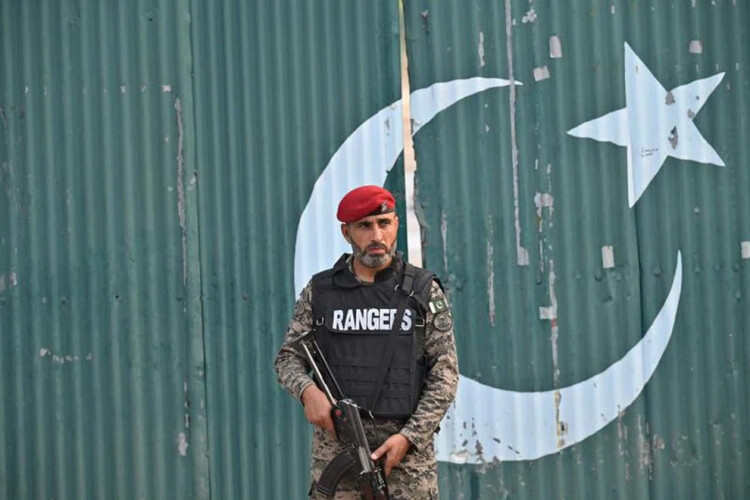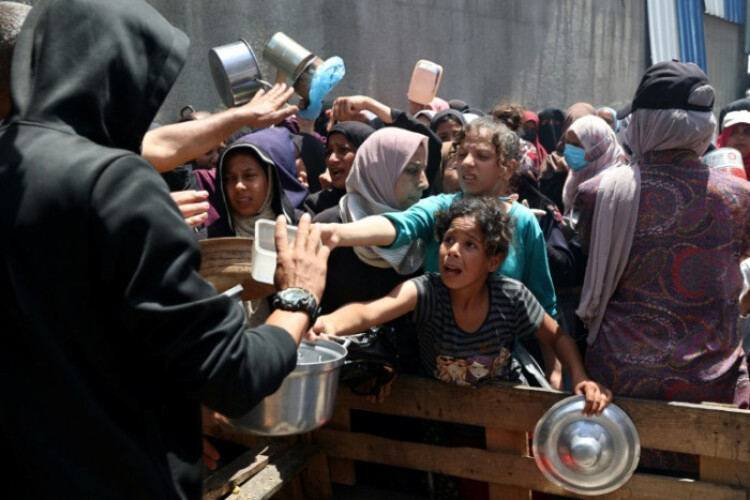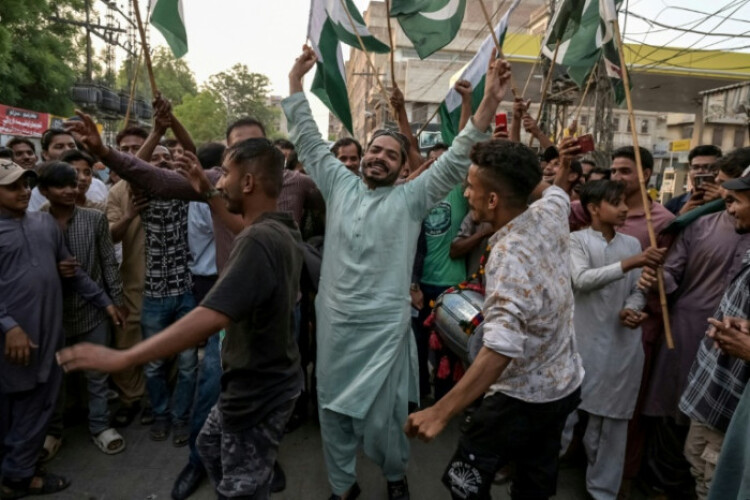
WASHINGTON - It took the possibility of a nuclear war breaking out on the Indian sub-continent to jolt the Trump administration into rushing to play peacemaker in a conflict that it had dismissed as “none of our business” just a day earlier.
The path that the conflict took from escalation to a ceasefire midwifed by the United States was predictable to analysts who follow the region.
Although India under Prime Minister Narendra Modi has appeared more aggressive towards Pakistan than the previous governments, the country remains primarily a status quo defensive power.
And the US, despite its stated reluctance to play global policeman, is seen as the only player with purchase over both India and Pakistan.
The sequence of events as pieced together by American media, quoting anonymous officials in the hours after a sudden ceasefire agreed on May 10 broke 96 hours of escalating cross-border tensions, went something like this:
Faced with a barrage of strikes from India on its military bases, Pakistan waved the nuclear card. Islamabad knew this would rouse the White House into action.
And India, too, estimated that Pakistan would flash the nuclear card and that the global community would spring to rein Islamabad in, so New Delhi could escalate its conventional military actions without the possibility of triggering a nuclear war.
It was a high-stakes game of chicken that has, for the time being, allowed each nation to claim a victory.
To India, as its Foreign Secretary Vikram Misri put it in a late night presser on May 10, the US put pressure on Pakistan, after which Pakistan’s military commander called his Indian counterpart.
Pakistan’s version is that India initiated the call.
The pattern of bravado and counter-claims would seem less than rational to outsiders, but it is not strange in the context of the sub-continent or to those who study it.
Nuclear threat?
US Vice-President J.D. Vance told Fox News on May 8 that while the US encouraged de-escalation, it was “not going to get involved in the middle of a war that is fundamentally none of our business”.
But in the space of less than 48 hours, President Donald Trump and Secretary of State Marco Rubio issued statements of having successfully mediated a ceasefire following talks with Indian Prime Minister Modi, Pakistani Prime Minister Shehbaz Sharif and military chief Asim Munir, and other senior officials.
Concern over explosions hitting the Noor Khan airbase in Rawalpindi, Pakistan, on May 9 was what drove Mr Vance and Mr Rubio into action, The New York Times reported on May 10.
The airbase lies near the headquarters of Pakistan’s Strategic Plans Division, which oversees and protects the country’s nuclear arsenal.
“Pakistan’s deepest fear is of its nuclear command authority being decapitated,” the Times quoted an unnamed former official saying.
“The missile strike on Noor Khan could have been interpreted, the former official said, as a warning that India could do just that.”
CNN, in a similar account, said White House chief of staff Susie Wiles was part of the core group of officials closely monitoring the crisis.
It quoted unnamed Trump administration officials as saying that the US had received “alarming intelligence”.
“While they declined to describe the nature of the information, citing its sensitivity, they said it was critical in persuading the three officials that the US should increase its involvement,” CNN said.
Local media reports in Pakistan reported that Mr Sharif had summoned a meeting of the National Command Authority, the body in charge of Pakistan’s nuclear weapons.
These reports were denied by Pakistan.
Mr Vance spoke to Mr Modi on May 9 (US Eastern time), saying that the White House believed there was a “high probability for dramatic escalation” that could tip into full-scale war, both the Times and CNN reported, quoting unnamed administration officials.
“Over the past 48 hours, V-P Vance and I have engaged with senior Indian and Pakistani officials, including prime ministers Narendra Modi and Shehbaz Sharif, External Affairs Minister Subrahmanyam Jaishankar, Chief of Army Staff Asim Munir, and national security advisers Ajit Doval and Asim Malik,” Mr Rubio said in a post on X.
It was not the first time the US had helped bring the two nuclear powers back from the brink.
In July 1999, then President Bill Clinton intervened after Pakistan issued veiled threats suggesting the possible use of nuclear weapons at the height of the Kargil War, which was fought in the high mountainous district in Ladakh and on the Line of Control, the de facto border.
Pakistan’s then Foreign Secretary Shamshad Ahmad had warned that escalation of the conflict could lead Pakistan to use “any weapon” in its arsenal, a statement widely interpreted as a nuclear threat.
This time, too, Pakistan was most likely threatening to go nuclear, said Dr Aparna Pande, a South Asia research fellow at Hudson Institute who has written several books on the foreign policies of Pakistan and India.
“Pakistan does that every time it fears that India may go up the ladder and especially if the world community is not paying enough attention. So, it brought out the nuclear card. They knew the US would immediately get nervous,” she said.
“And India knew Pakistan would play this card,” she added. It also knew the global community would come in and that it could escalate without triggering a nuclear war scenario.
While India has a “no first use” nuclear doctrine, restricting the use of such weapons to only retaliation, Pakistan does not.
“India is a status quo non-escalatory defensive power,” she said. “It will not turn offensive overnight, irrespective of the political party in power.”
The US intervention set off a series of events that resulted in talks between the two countries’ military officials and the subsequent declaration of a cessation of attacks.
Who called whom first is a matter of dispute, and both Pakistan and India have claimed that the other breached the ceasefire soon after it went into effect at a time they both agreed.
Dr Pande dismissed the denials and counter-denials as routine. “It is typical sub-continent culture,” she said.
“You are looking for rationality where there is none.”
Dr Tanvi Madan, a senior fellow at the Centre for Asia Policy Studies at the Brookings Institution in Washington, said the Trump administration had learnt first-hand what American strategic thinker Stephen Cohen wrote about two decades ago: “Pakistan now negotiates with its allies and friends by pointing a gun to its own head.”
The late Dr Cohen, the author of the 2004 book The Idea Of Pakistan, was considered a leading expert on South Asian security issues.
The US, however, was not alone in wanting to calm the waters.
Pakistan’s Foreign Minister Ishaq Dar told Pakistani media that three dozen countries, including Turkey and Saudi Arabia, were involved in diplomatic efforts.
Dr Madan also commented on China’s role in the crisis after perusing the translation of China’s readouts of talks with Pakistani and Indian officials.
It appeared that Beijing sought de-escalation, especially after sabre-rattling by Pakistan, and asked it to “make a decision... in line with Pakistan’s fundamental and long-term interests”.
China also made no criticism of India’s military strikes, she noted.
To date, neither Mr Modi nor General Munir, the de facto power player in Pakistan, have publicly commented on developments.
While the guns may have largely fallen silent across the border and Washington takes some satisfaction in its role in de-escalation, peace remains fragile.
Asia News Network/The Straits Times
The path that the conflict took from escalation to a ceasefire midwifed by the United States was predictable to analysts who follow the region.
Although India under Prime Minister Narendra Modi has appeared more aggressive towards Pakistan than the previous governments, the country remains primarily a status quo defensive power.
And the US, despite its stated reluctance to play global policeman, is seen as the only player with purchase over both India and Pakistan.
The sequence of events as pieced together by American media, quoting anonymous officials in the hours after a sudden ceasefire agreed on May 10 broke 96 hours of escalating cross-border tensions, went something like this:
Faced with a barrage of strikes from India on its military bases, Pakistan waved the nuclear card. Islamabad knew this would rouse the White House into action.
And India, too, estimated that Pakistan would flash the nuclear card and that the global community would spring to rein Islamabad in, so New Delhi could escalate its conventional military actions without the possibility of triggering a nuclear war.
It was a high-stakes game of chicken that has, for the time being, allowed each nation to claim a victory.
To India, as its Foreign Secretary Vikram Misri put it in a late night presser on May 10, the US put pressure on Pakistan, after which Pakistan’s military commander called his Indian counterpart.
Pakistan’s version is that India initiated the call.
The pattern of bravado and counter-claims would seem less than rational to outsiders, but it is not strange in the context of the sub-continent or to those who study it.
Nuclear threat?
US Vice-President J.D. Vance told Fox News on May 8 that while the US encouraged de-escalation, it was “not going to get involved in the middle of a war that is fundamentally none of our business”.
But in the space of less than 48 hours, President Donald Trump and Secretary of State Marco Rubio issued statements of having successfully mediated a ceasefire following talks with Indian Prime Minister Modi, Pakistani Prime Minister Shehbaz Sharif and military chief Asim Munir, and other senior officials.
Concern over explosions hitting the Noor Khan airbase in Rawalpindi, Pakistan, on May 9 was what drove Mr Vance and Mr Rubio into action, The New York Times reported on May 10.
The airbase lies near the headquarters of Pakistan’s Strategic Plans Division, which oversees and protects the country’s nuclear arsenal.
“Pakistan’s deepest fear is of its nuclear command authority being decapitated,” the Times quoted an unnamed former official saying.
“The missile strike on Noor Khan could have been interpreted, the former official said, as a warning that India could do just that.”
CNN, in a similar account, said White House chief of staff Susie Wiles was part of the core group of officials closely monitoring the crisis.
It quoted unnamed Trump administration officials as saying that the US had received “alarming intelligence”.
“While they declined to describe the nature of the information, citing its sensitivity, they said it was critical in persuading the three officials that the US should increase its involvement,” CNN said.
Local media reports in Pakistan reported that Mr Sharif had summoned a meeting of the National Command Authority, the body in charge of Pakistan’s nuclear weapons.
These reports were denied by Pakistan.
Mr Vance spoke to Mr Modi on May 9 (US Eastern time), saying that the White House believed there was a “high probability for dramatic escalation” that could tip into full-scale war, both the Times and CNN reported, quoting unnamed administration officials.
“Over the past 48 hours, V-P Vance and I have engaged with senior Indian and Pakistani officials, including prime ministers Narendra Modi and Shehbaz Sharif, External Affairs Minister Subrahmanyam Jaishankar, Chief of Army Staff Asim Munir, and national security advisers Ajit Doval and Asim Malik,” Mr Rubio said in a post on X.
It was not the first time the US had helped bring the two nuclear powers back from the brink.
In July 1999, then President Bill Clinton intervened after Pakistan issued veiled threats suggesting the possible use of nuclear weapons at the height of the Kargil War, which was fought in the high mountainous district in Ladakh and on the Line of Control, the de facto border.
Pakistan’s then Foreign Secretary Shamshad Ahmad had warned that escalation of the conflict could lead Pakistan to use “any weapon” in its arsenal, a statement widely interpreted as a nuclear threat.
This time, too, Pakistan was most likely threatening to go nuclear, said Dr Aparna Pande, a South Asia research fellow at Hudson Institute who has written several books on the foreign policies of Pakistan and India.
“Pakistan does that every time it fears that India may go up the ladder and especially if the world community is not paying enough attention. So, it brought out the nuclear card. They knew the US would immediately get nervous,” she said.
“And India knew Pakistan would play this card,” she added. It also knew the global community would come in and that it could escalate without triggering a nuclear war scenario.
While India has a “no first use” nuclear doctrine, restricting the use of such weapons to only retaliation, Pakistan does not.
“India is a status quo non-escalatory defensive power,” she said. “It will not turn offensive overnight, irrespective of the political party in power.”
The US intervention set off a series of events that resulted in talks between the two countries’ military officials and the subsequent declaration of a cessation of attacks.
Who called whom first is a matter of dispute, and both Pakistan and India have claimed that the other breached the ceasefire soon after it went into effect at a time they both agreed.
Dr Pande dismissed the denials and counter-denials as routine. “It is typical sub-continent culture,” she said.
“You are looking for rationality where there is none.”
Dr Tanvi Madan, a senior fellow at the Centre for Asia Policy Studies at the Brookings Institution in Washington, said the Trump administration had learnt first-hand what American strategic thinker Stephen Cohen wrote about two decades ago: “Pakistan now negotiates with its allies and friends by pointing a gun to its own head.”
The late Dr Cohen, the author of the 2004 book The Idea Of Pakistan, was considered a leading expert on South Asian security issues.
The US, however, was not alone in wanting to calm the waters.
Pakistan’s Foreign Minister Ishaq Dar told Pakistani media that three dozen countries, including Turkey and Saudi Arabia, were involved in diplomatic efforts.
Dr Madan also commented on China’s role in the crisis after perusing the translation of China’s readouts of talks with Pakistani and Indian officials.
It appeared that Beijing sought de-escalation, especially after sabre-rattling by Pakistan, and asked it to “make a decision... in line with Pakistan’s fundamental and long-term interests”.
China also made no criticism of India’s military strikes, she noted.
To date, neither Mr Modi nor General Munir, the de facto power player in Pakistan, have publicly commented on developments.
While the guns may have largely fallen silent across the border and Washington takes some satisfaction in its role in de-escalation, peace remains fragile.
Asia News Network/The Straits Times










